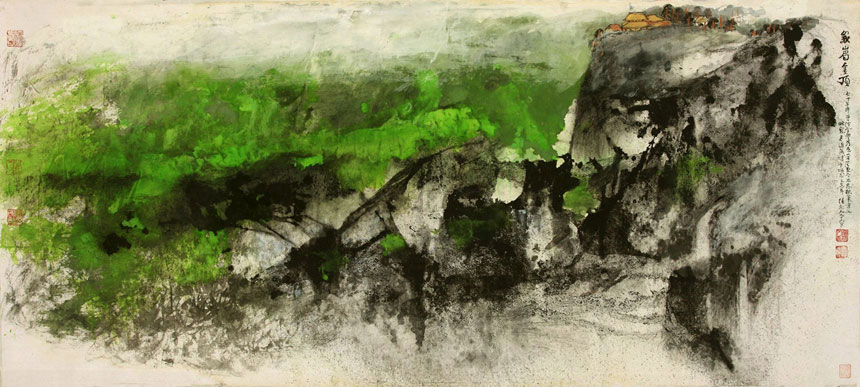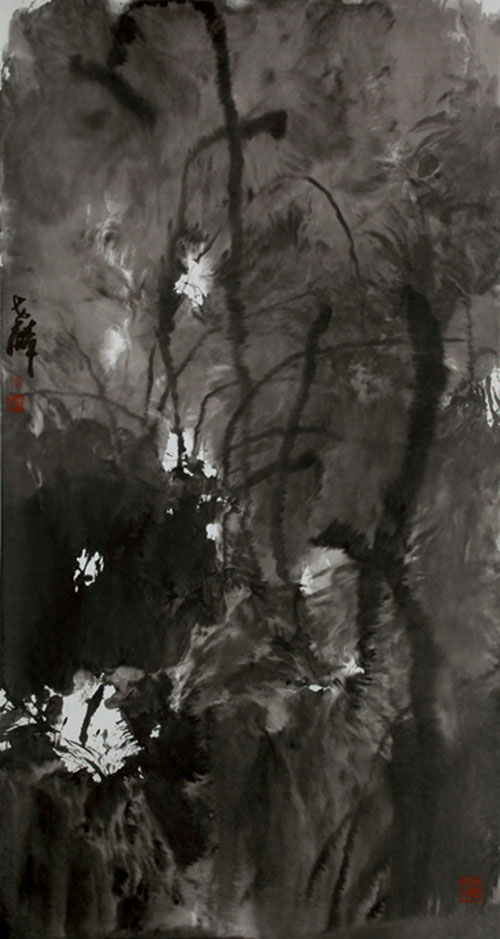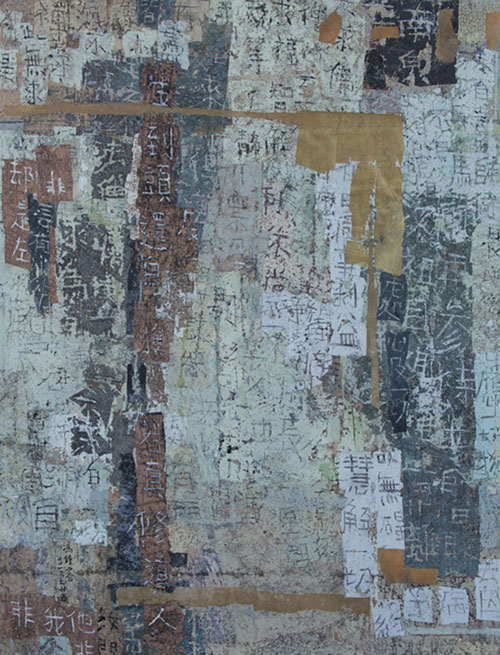East West Lifestyle
Contempor’ati: Art that Bridges Tradition and Modernity
By Angela Bao

An exhibit that brings back China's centuries-old literati tradition, but with a twist.
Contempor’ati Studios is a participant in Asia Week San Francisco Bay Area (Asia Week SFBA), which runs from Sept. 30 to Oct. 8. Asia Week brings all forms of Asian art together to promote and showcase the richness and diversity of Asian culture. The Contempor’ati exhibit will remain on display until Jan. 5 at the Pacific Heritage Museum.
Literati painting, known as wenrenhua in Mandarin, is a traditional form of Chinese ink painting that was considered the highest form of art by the educated elite. It was plain in style and, at most, used minimal color and often incorporated poetry and calligraphy, the latter of which was considered the pinnacle of scholarly art. During the Yuan Dynasty, many Chinese scholars refused to work in government posts, the traditional track of the educated elite, under the Mongolian rulers and instead turned toward art. As more and more literary scholars took up painting, a new art form began to emerge: literati painting. These scholar-painters noticed that the line played a fundamental role in both calligraphy and ink painting and started integrating the two; eventually, literati painters began including their own lines of poetry, calligraphy and even personal notes into their paintings to display both their skills and individuality. Compared with academic or “professional” painters, who mainly focused on realism and decorative aspects, these scholar-painters aimed to reveal their true inner characters through their art.
“Literati painters put great emphasis on the idea that the style with which a painter controlled his brush conveyed the inner style of his character,” says Manni Liu, first vice president and customer communications manager at East West Bank, who coordinated the upcoming Contempor’ati Studios exhibit at the Pacific Heritage Museum. “Brushstrokes were seen as expressions of the spirit rather than just matters of composition or skill.”
Although Chinese literati art has played a large and influential part in Chinese history and culture, it has largely been forgotten by modern society. Edward Gui, the director of Asia Week SFBA, believes that the Contempor’ati exhibit will preserve some of that history while still resonating with a modern-day audience. “Asia Week is committed to establishing a broad platform to showcase and promote Asian art,” says Gui. “Contempor’ati celebrates and inspires the Chinese literati tradition in a new and contemporary way, which complements well the overall Asia Week mission and theme.”
Incorporating literati tradition into contemporary art
Contempor’ati Studios showcases literati art by contemporary Chinese artists. All of the artworks have clear roots in the literati tradition – these works often center on nature and calligraphy, traditional literati subjects – yet have been “updated” with modern-day techniques: usage of bright color, abstraction, collage, etc. As a result, these contemporary literati pieces feel as if they are visual melting pots, using styles and mediums taken from the past and the present, the East and the West, to create something that transcends any single culture.
“Our mission,” says Jean Song, the curator of Contempor’ati, “is to educate and inform more people about the contemporary literati lifestyle, in forms that a broader audience can appreciate.” Song hopes that the exhibit will invigorate interest in literati history and culture, as well as push people to recognize the universality of art. “It’s all about bridging cultural divides,” she says. “The best art creates a universal language. It belongs to no one and to everyone at the same time.”
The exhibit features three Chinese artists who seamlessly mold Eastern and Western styles and embody the spirit of “contempor’ati”: Hou Beiren, Zhou Shilin and Fong Chung-Ray.
Hou Beiren, who turned 99 years old this year, is regarded as one of China’s most important contemporary artists. His art has been exhibited and collected all over the world, including by the de Young Museum in San Francisco and by the Museum der Moderne in Austria. Although Hou is sometimes referred to as “China’s Picasso,” the comparison is a little misleading, partly because Hou has lived in the United States since 1956 and partly because Hou’s style is wildly different from Picasso’s.

As a true modern-day scholar-painter, Hou’s works draw heavily on traditional ink painting and calligraphy. The subjects of his paintings typically follow that of classical Chinese art: paintings of villages and temples, studies of the natural world, all usually accompanied by Chinese poetry. However, Hou imbues his works with brilliant splashes of color (a style known as “splash color” or “splash ink and color”) that infuse his otherwise serene compositions with the intensity and liveliness of Western-style Abstract Impressionism.
Zhou Shilin is one of China’s most popular and widely collected painters, as well as a fully tenured professor at the Tianjin Academy of Fine Arts, one of China’s most prestigious art schools. Zhou was formally trained in oil painting at Beijing’s Central Academy of Fine Arts, and is fluent in both oil and ink mediums. Although his oil paintings are more heavily Western-influenced, Zhou’s ink works are a true bridge between East and West. Zhou also utilizes the “splash color” style, but he incorporates oil painting techniques into those works to create dimensions and textures that abstract his otherwise traditional Chinese imagery into something fresh and modern.
"There are a lot of myths about poor people and homeless people. I don’t think people realize how hard it is to be either. "

Fong Chung-Ray, Song says, is one of the true pioneers of Chinese “contempor’ati” art. While living in Taiwan in the 1950s, Fong discovered Western art books at the U.S. Information Service center (now known as the American Cultural Center) in Taipei and became enamored with abstract art. “Fong pushed the boundaries of abstract innovation,” says Song, “even using materials like palm leaves as brushes.” As a result, his work often has a collage feel, a byproduct of his Western and Chinese influences, which creates visual textures evocative of the natural landscapes popular in traditional literati painting.
Bridging the East and the West
As reflected by her choice of artists, Song’s purpose in curating the Contempor’ati exhibit is to show how art can bridge cultural divides and unite seemingly opposite things – the modern with the traditional, the East with the West. “What we are seeing now is the globalization of art and art appreciation around the world,” says Song. “Over the last 30-plus years, there’s been an incredible exchange between Eastern art and artists and their Western counterparts. Soon both [sides] will have a fuller appreciation of master artists and their creations, whether they are from the East or the West.”
The Bay Area itself is a fitting representation of that cultural mélange. 2010 U.S. Census Bureau figures show almost 48 percent of the population in the area are people of color and more than 23 percent are of Asian descent – the perfect place to host Contempor’ati and Asia Week. “The San Francisco Bay Area is one of the most diverse and dynamic regions in the world,” says Gui. “Given the strong Asian population in this region, a platform to showcase and promote Asian art is much needed, and [we hope that] it will further foster cultural diversity.”
The exhibit’s location also ties into the theme of Contempor’ati. The Pacific Heritage Museum, which is owned by East West Bank and adjacent to the company’s San Francisco headquarters, is a historical landmark. Originally the site of a U.S. Branch Mint, the museum has since been carefully restored and turned into a gallery space and historical exhibit. “The Pacific Heritage Museum is also uniquely situated between San Francisco’s Financial District and Chinatown,” adds East West Bank’s Liu. The museum attracts many different types of people, tourists as well as local visitors, and serves as its own miniature melting pot of cultures.
Sign up for the Reach Further Newsletter
We’ll keep you in the know about the latest US-Asia business news and trends.
Suscríbase al boletín Reach Further
Lo mantendremos informado sobre las últimas noticias y tendencias comerciales entre Estados Unidos y China.

